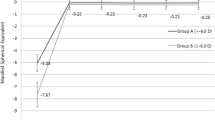Abstract
Purpose
To study the outcomes of small-incision lenticule extraction (SMILE) for treatment of myopia and myopic astigmatism.
Methods
Retrospective study of patients treated for myopia or myopic astigmatism with SMILE, using a VisuMax® femtosecond laser (Carl Zeiss Meditec, Jena, Germany), at the Department of Ophthalmology, Odense University Hospital, Odense, Denmark. Inclusion criteria were corrected distance visual acuity (CDVA) of 20/25 or better before surgery and no ocular conditions other than myopia up to −10.00 diopters (D) with astigmatism up to 3.00 D.
Results
Of the 729 treatments, 722 were included. The spherical equivalent (SE) refraction averaged −6.82 ± 1.66 diopters (D) before surgery. After 3 months, 88 % of eyes were within ±0.50 D of the intended refraction, whilst 98 % were within ±1.00 D. The mean difference between attempted and achieved SE refraction at 3 months after surgery was −0.06 ± 0.01 D (range: −1.25 to 1.25 D). In eyes with emmetropia as target refraction (n = 362), 63 % had uncorrected distance visual acuity (UDVA) of 20/25 or better 1 day after surgery, rising to 83 % at 3 months after surgery. The average gain in CDVA from before surgery to 3 months after surgery was 0.07 ± 0.03 (logMAR). However, 12 eyes (1.6 %) lost 2 or more lines of CDVA from before surgery to 3 months postoperatively. Simultaneous treatment of up to 3.00 D of astigmatism was not associated with less predictable refractive outcomes.
Conclusions
In the short term, SMILE seemed predictable, efficient, and safe for treatment of myopia and myopic astigmatism.






Similar content being viewed by others
References
Sekundo W, Kunert KS, Blum M (2011) Small incision corneal refractive surgery using the small incision lenticule extraction (SMILE) procedure for the correction of myopia and myopic astigmatism: results of a 6 month prospective study. Br J Ophthalmol 95(3):335–339
Reinstein DZ, Archer TJ, Randleman JB (2013) Mathematical model to compare the relative tensile strength of the cornea after PRK, LASIK, and small incision lenticule extraction. J Refract Surg 29(7):454–460
Vestergaard AH, Gronbech KT, Grauslund J, Ivarsen AR, Hjortdal JO (2013) Subbasal nerve morphology, corneal sensation, and tear film evaluation after refractive femtosecond laser lenticule extraction. Graefe's Arch Clin Exp Ophthalmol 251(11):2591–2600
Xu Y, Yang Y (2014) Dry eye after small incision lenticule extraction and LASIK for myopia. J Refract Surg 30(3):186–190
Vestergaard A, Ivarsen A, Asp S, Hjortdal JO (2013) Femtosecond (FS) laser vision correction procedure for moderate to high myopia: a prospective study of ReLEx((R)) flex and comparison with a retrospective study of FS-laser in situ keratomileusis. Acta Ophthalmol 91(4):355–362
Ganesh S, Gupta R (2014) Comparison of visual and refractive outcomes following femtosecond laser-assisted lasik with smile in patients with myopia or myopic astigmatism. J Refract Surg 30(9):590–596
Moshirfar M, McCaughey MV, Reinstein DZ, Shah R, Santiago-Caban L, Fenzl CR (2015) Small-incision lenticule extraction. J Cataract Refract Surg 41(3):652–665
Hjortdal JO, Vestergaard AH, Ivarsen A, Ragunathan S, Asp S (2012) Predictors for the outcome of small-incision lenticule extraction for Myopia. J Refract Surg 28(12):865–871
Chen YI, Chien KL, Wang IJ, Yen AM, Chen LS, Lin PJ, Chen TH (2007) An interval-censored model for predicting myopic regression after laser in situ keratomileusis. Invest Ophthalmol Vis Sci 48(8):3516–3523
Yang CC, Wang IJ, Chang YC, Lin LL, Chen TH (2006) A predictive model for postoperative intraocular pressure among patients undergoing laser in situ keratomileusis (LASIK). Am J Ophthalmol 141(3):530–536
Potgieter FJ, Roberts C, Cox IG, Mahmoud AM, Herderick EE, Roetz M, Steenkamp W (2005) Prediction of flap response. J Cataract Refract Surg 31(1):106–114
Liyanage SE, Allan BD (2012) Multiple regression analysis in myopic wavefront laser in situ keratomileusis nomogram development. J Cataract Refract Surg 38(7):1232–1239
Holladay JT (2004) Visual acuity measurements. J Cataract Refract Surg 30(2):287–290
Lin F, Xu Y, Yang Y (2014) Comparison of the visual results after SMILE and femtosecond laser-assisted LASIK for myopia. J Refract Surg 30(4):248–254
Shortt AJ, Allan BD, Evans JR (2013) Laser-assisted in-situ keratomileusis (LASIK) versus photorefractive keratectomy (PRK) for myopia. Cochrane Database Syst Rev 1:Cd005135
Ivarsen A, Asp S, Hjortdal J (2014) Safety and complications of more than 1500 small-incision lenticule extraction procedures. Ophthalmology 121(1):822–828
Ivarsen A, Hjortdal J (2014) Correction of myopic astigmatism with small incision lenticule extraction. J Refract Surg 30(4):240–247
Wan-Soo K, Jin-Man J (2001) Corneal hydration affects ablation during laser in situ keratomileusis surgery. Cornea 20(4):394–397
Author information
Authors and Affiliations
Corresponding author
Ethics declarations
Funding
No funding was received for this research.
Conflict of interest
All authors certify that they have no affiliations with or involvement in any organization or entity with any financial interest (such as honoraria; educational grants; participation in speakers’ bureaus; membership, employment, consultancies, stock ownership, or other equity interest; and expert testimony or patent-licensing arrangements), or non-financial interest (such as personal or professional relationships, affiliations, knowledge or beliefs) in the subject matter or materials discussed in this manuscript.
Ethical approval
All procedures performed in studies involving human participants were in accordance with the ethical standards of the institutional and/or national research committee and with the 1964 Helsinki declaration and its later amendments or comparable ethical standards.
Informed consent
Informed consent was obtained from all individual participants included in the study.
Rights and permissions
About this article
Cite this article
Hansen, R.S., Lyhne, N., Grauslund, J. et al. Small-incision lenticule extraction (SMILE): outcomes of 722 eyes treated for myopia and myopic astigmatism. Graefes Arch Clin Exp Ophthalmol 254, 399–405 (2016). https://doi.org/10.1007/s00417-015-3226-5
Received:
Revised:
Accepted:
Published:
Issue Date:
DOI: https://doi.org/10.1007/s00417-015-3226-5




